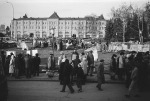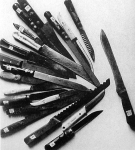My Second Close Encounter With a Serial Killer: Andrei Chikatilo.
My first random encounter with a serial killer (Richard Cottingham) in 1979 was a hell of a story and I told it over drinks and dinners for a long time, long after I had met, but did not know it, yet another serial killer—one for the record books, the Ukrainian cannibal Andrei Chikatilo, who killed and mutilated an extraordinary fifty-three victims in the Soviet Russia.
In October 1990 I was shooting a television documentary in Moscow about the changes taking place there as the Soviet communist system was collapsing. One day we came upon an extraordinary sight. A tent city with about five hundred protestors had been spontaneously erected on the front lawn of a hotel immediately behind the Red Square beneath the domes of St. Basil’s Cathedral. The demonstrators seemed to have come in from all parts of the country and were mostly aged pensioners protesting Stalinist abuses of the past. They had bizarre placards attached to their tents and shelters. Some pasted to their foreheads little slips of paper protesting strange things written in broken English, such as “Lenin is bonehead.” Others held up placards with elaborately laid-out documents, letters, and photographs documenting their complaints.




I waded into the crowd with my cinematographer, Tony Wannamaker, and started speaking with some of the people, seeking out possible interviews to film. It seemed that almost everybody there was somehow traumatized or mentally ill, and considering what had happened to them during the Stalin era, it was understandable.
Suddenly I spotted a small stand decorated with the white, blue, and red of the old Imperial Russian tricolor flag. In 1990 it was still a rare thing to see those colors in the USSR. It belonged to a gaunt man with graying hair and big framed glasses. His other features I cannot recall, other than his being closely shaved and dressed relatively well (for Soviet-era Russia) in a cheap mid-length winter jacket, clean shirt, and neatly knotted tie. He looked to be maybe in his late forties or early fifties and stood out with his neat dress and younger age when compared to the many raggedy-scruffy bearded Russian pensioners occupying the tent city around him. There was something refined about him—perhaps even delicate or prissy. Next to him was a typical battered leather briefcase like those that almost every Soviet bureaucrat and office worker carried.
He introduced himself, but I forgot his name later and where he said he came from. At first he spoke quietly, calmly, and in a highly educated manner. The few phrases he attempted in English were well pronounced and grammatical. He reminded me of a librarian. He explained that he held several university degrees and was “not like” the rest of the rabble there. As his story began to pour out, he gradually was overcome with emotion; his eyes welled up with tears and his glasses actually fogged up. But his story was so absurd that I would never forget it: He was here in Moscow, he told me, to see President Gorbachev to complain that somebody was building an illegal garage and toilet beneath the windows of his son’s apartment in Rostov. It was a conspiracy, he wailed.
[image error]
I had just interviewed an old woman a few rows away who had told me she was dying of cancer and fifty years earlier had been arrested and put in the Gulag slave labor camp system while her children were sent to a state institution. She had not seen them since and was desperate to find them before she died, but the authorities were not helping. This neatly dressed man’s prissy complaints about some garage seemed to me petty and stupid in comparison—and worse: boring television.
Broadcast videotape was precious and difficult to find in Russia back then, and I did not want to waste it on this guy. Tony and I had a codeword: “this is a Kodak moment.” It meant, don’t waste videotape recording this; let’s move on. Searching for somebody else to interview, we drifted away from him as fast as we politely could, not even listening to the last few things he had to say, and quickly forgot all about him.
That is how I missed filming an interview with Andrei Romanovich Chikatilo—the “Red Ripper”—“Citizen X”—”The Butcher of Rostov”–three weeks before his capture—one of the most prolific serial killers in modern history.
[image error] [image error]
Between 1978 and 1990, Chikatilo murdered, mutilated and cannibalized 53 women, male and female youths and children. (He confessed to 56 and was convicted for 52.) He killed women, girls, boys, and youths indiscriminately, almost always luring them either to a killing shack he kept in a seedy part of town or to isolated fields or woods. He used his refined and educated persona to seduce his victims into trusting him. Often preying on the destitute, the mentally handicapped, the lost, and the young, he offered food, sex, shelter, or directions to entice his victims to accompany him to their deaths. Once he had his victims isolated, he would brutally attack and mutilate them using a “killing kit” of various knives and sharp instruments he carried with him in his briefcase.


Within days of my brief conversation with him in the Moscow tent city, he would return to his home in Rostov in the Ukraine to kill his fifty-first known victim. Riding on a local train, he convinced a sixteen-year-old mentally handicapped boy to accompany him to his “cottage” with the promise that there were girls there. The two got off the train and Chikatilo walked the boy into a dense wood, where he suddenly forced him to the ground and ripped off his trousers. He tied the boy with a rope that he carried with him in his briefcase just for that kind of occasion and then rolled him over and removed the rest of his clothes. (Was it the same briefcase I saw that day in the tent city?) He molested him and then bit off the tip of the boy’s tongue and stabbed him repeatedly in the head and stomach. Afterward he cut off the boy’s genitals and threw them into the bushes. After dragging the body into some thick undergrowth he recovered the rope and wiped the blood off himself and his knife with the boy’s clothes. He straightened out his own clothing (and was it the same shirt and tie I saw him in?) and then calmly returned to the nearby railway station and took the train home.
Ten days later at a different railway station, Chikatilo killed another sixteen-year-old boy, mutilating him in a similar fashion, his fifty-second victim.
A week later, behind the same station where he killed the mentally handicapped youth, he murdered his fifty-third and final victim, a twenty-two-year-old woman. He cut off the tip of her tongue and both her nipples after mutilating her genitals. After he emerged from the bush with blood smeared on his face, he was washing up at a platform water tap when a police officer, on the lookout for a killer, briefly questioned Chikatilo and recorded his identification. He was allowed to continue on his way—the police officer later stated that he had no way of determining that the smear on Chikatilo’s face was actually blood. Gorbachev’s new rules of civil society strictly regulated police conduct toward citizens—everything was to be done by the book now. The police officer let Chikatilo go, but for the next few days he was put under surveillance.
When the body of the female victim was eventually discovered near the station where he was questioned, Chikatilo was immediately arrested.
The following year I watched the Chikatilo trial broadcast on Russian television and saw photographs of him in the press. By the time the trial began, Chikatilo’s head was shaved and he appeared quite mad, exposing himself and howling at the courtroom spectators from within a specially built cage.






But even seeing the earlier photographs of him in the press, I never recognized him from that day I met him in the Moscow tent city. I still occasionally told my Richard Cottingham story, never realizing what punchline lurked beyond it. It was only years later that I came across a transcript of Chikatilo’s police interrogation in which he complained about the conspiratorial attempt to build a garage and toilet behind his son’s apartment and his intention to meet with Gorbachev in Moscow. I was transfixed in horror—could it possibly be the same guy? It had to be—the story was just too eccentric, and even the Russian investigator remarked on Chikatilo’s emotional peaks when he began to speak of the garage. Indeed, after some further research I uncovered an account of Chikatilo’s visit to Moscow in October 1990 just before he committed his last three murders.
Of Chikatilo himself, I have no memory—just that of his ridiculous story in the tent city and fragmentary glimpses of the monster: glasses, the knot of his tie, a clean-shaven cheek, a briefcase lying in the grass by his feet—but of him . . . nothing. This invisibility let him kill fifty-three people and almost walk away untouched, with blood on his face, from a police officer looking for him. What manner of ghoulish monsters were these?
I came to realize that in my life I had met not one, but two serial killers—unidentified and out there killing—and for the longest time I had not even known it. How many more could there be? And where the hell were they coming from?
I was puzzled by the conventional backgrounds of these two killers—both gainfully employed family men: Cottingham, a New York City computer operator with a house and three kids in the suburbs; and Chikatilo, a university-educated schoolteacher, father of two children, writer of political essays for Soviet publications, and, later, factory materials purchaser. These two were not grizzled glassy-eyed drifters or twitchy recluses—types we frequently associate with serial killers. They were ordinary.
Most of all, I was fascinated with their invisibility—their forgettability. Apparently, they stalked and killed like evil transparent ghosts. Even when I had run into Cottingham, presumably carrying two severed heads and having just set fire to a hotel I was checking into, I would forget him within seconds of the encounter. Cottingham was so forgettable that after leaving behind a mutilated corpse under a motel bed, he checked back into the very same motel a mere eighteen days later, and nobody recognized him.
While Richard Cottingham I remembered, I forgot everything about Chikatilo other than the neatness of his dress and the banality of his complaint. I do not remember his eyes, other than the tears in them and the fogged veil of the lenses in his glasses; nothing of his face other than it was clean shaven. He remains but a softly spoken shadowy politeness in my memory—but in my nightmares, he stills comes to me as a monstrous geek with eyeless sockets spewing tears.
[image error]
All of this led me to contemplate how Cottingham and Chikatilo came to exist—where had they sprung from and by what means and paths did they move about for me to so randomly stumble across these two homicidal monsters, roaming free in the wild among us?
In my attempt to map the primordial substance from which they rose, I came to write Serial Killers: The Method and Madness of Monsters, and in a way, map my own substance as well. Was there something about me that led me to cross the paths of these two serial killers so seemingly at random? I learned that many victims of serial killers “facilitate” their own deaths by their choice of lifestyle or behavior—hitchhikers, runaways, street hookers. While not a victim, I perhaps facilitated my meeting with Cottingham by my choice of hotels near a hookers’ stroll. I strayed into a serial killer’s hunting grounds as a trespasser and got a bump from a monster.
While my Cottingham encounter in New York was one of those experiences that one can easily write off as coincidence, my second encounter with a serial killer made me wonder. I questioned the mathematical odds of running into two killers in that manner. One killer I could easily understand, but two made me ask, how many more might there be out there that I did not know about? I wondered what the odds were of walking by a serial killer without ever finding out about it—on the street, waiting in line for a burger, browsing for books in a true-crime section, or sitting next to one on a train or bus? I shuddered when I heard somebody explain that serial killers might be strangers—but only to you. They become very familiar with you if they pick you as their target—you are no stranger to them.
It seemed to me that millions of people move about their daily lives without meeting a serial killer—or at least, without finding out they had met one. Perhaps that is precisely what makes me different from you—that I have uncovered the transparent monsters who had tramped across my path—my serial killers—while you perhaps have not uncovered yours. I pray you never will.
Andrei Chikatilo was executed in 1994.
From Serial Killers: The Method and Madness of Monsters
[image error]





